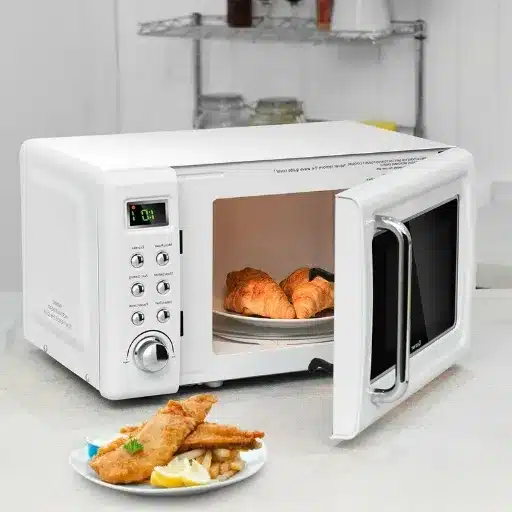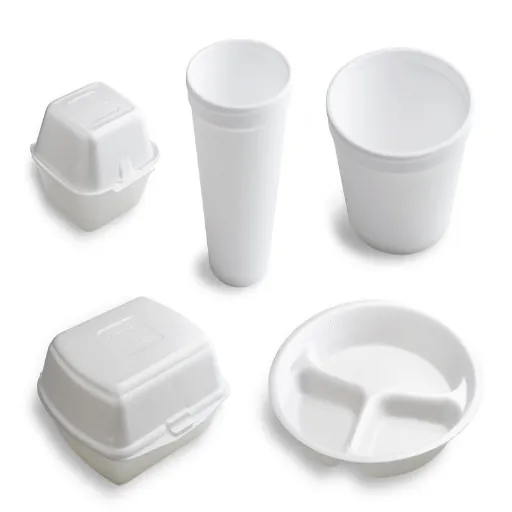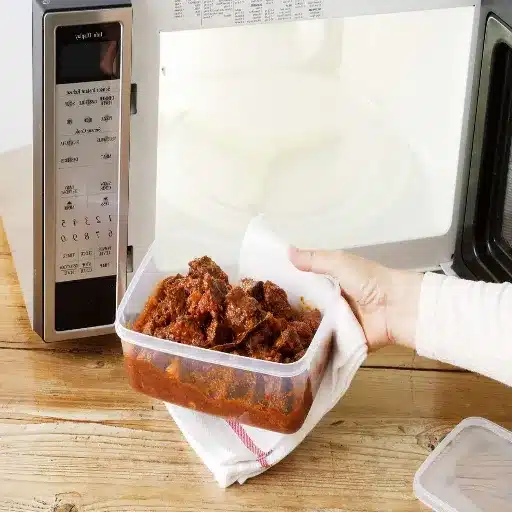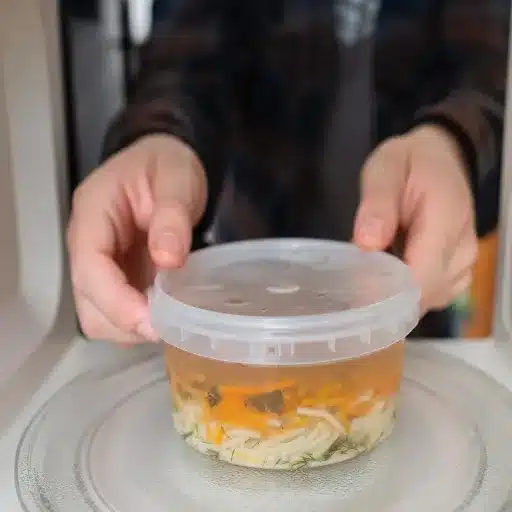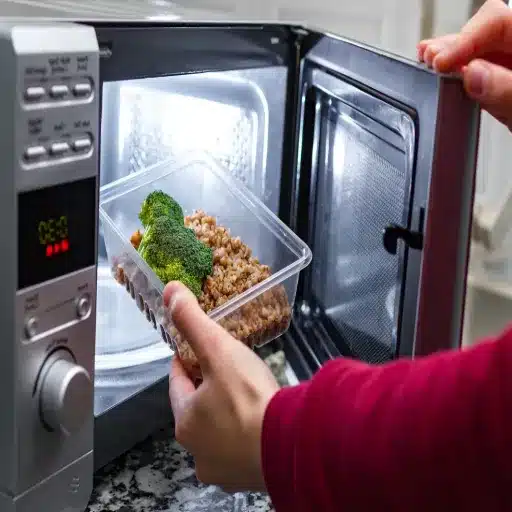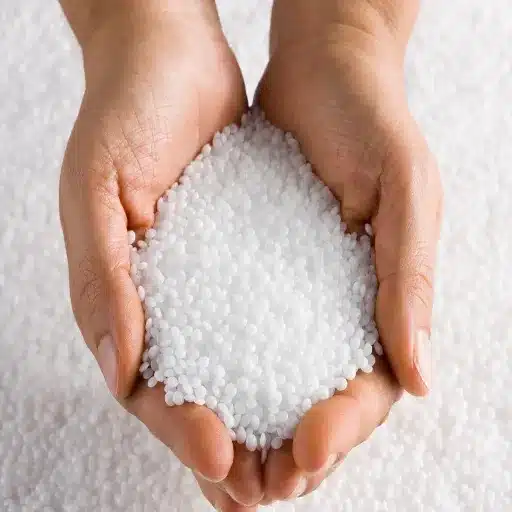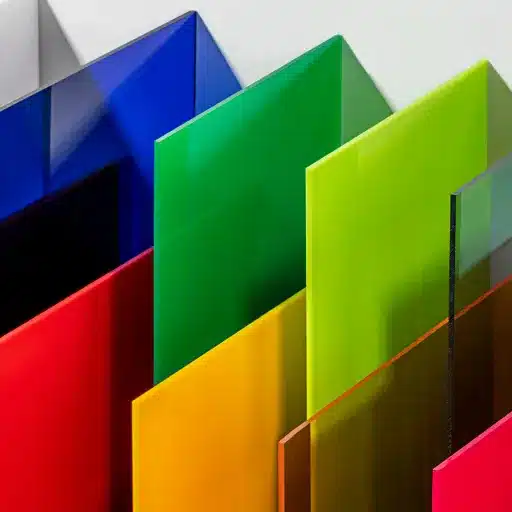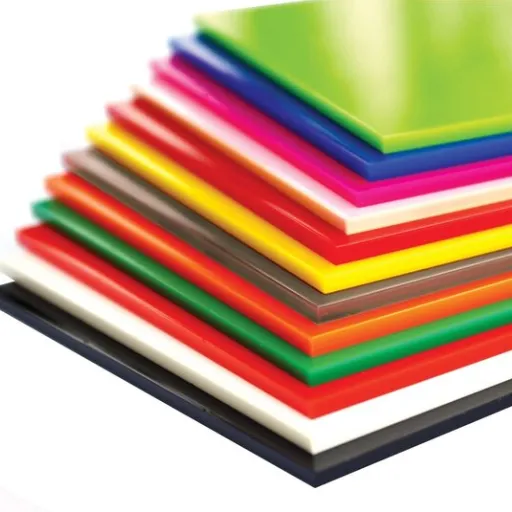The leftovers came from your favorite takeout place. The container was a light, white foam box. The following day, you took round two and directly put it into the microwave. Maybe you have the question in your mind while the turntable spins: would it be safe to microwave this? Is PS 6 microwave safe?
What We have here is a question that people often ask in the kitchen. For the sake of ease and comfort, we usually use plastic and foam containers, but the situation is not the same when it comes to not-knowing the materials and not being able to make good choices. We may see the digits and signs down the bottom of the containers as a secret code, which makes us all confused.
This guide is designed to sort out the troubles related to microwaving plastics, in particular PS 6, which is also called polystyrene or Styrofoam. We’ll find out the real meaning of “microwave-safe”, bring up the possible health hazards resulting from a few plastics when heated and give you some easy ways to reheat your food safely. Consequently, not only will you choose the safest containers without any doubts, but you will also take care of your health at the same time.
Understanding Microwave Safety
What Does “Microwave-Safe” Mean?
The product is called “microwave-safe” when the manufacturer has tested it and approved it to be used in a microwave oven. The FDA, the U. S. food and drug administration, regulates these products as well, in order to guarantee that the amount of chemicals that will go from the container to the food does not surpass certain levels, thus, the food and its container will remain apart.
A microwave-safe container will not:
- Melt or warp: It can hold its shape even when exposed to the high heat generated by microwaves.
- Release harmful chemicals: It is made from materials that are stable and do not break down and leach into your food.
- Catch fire: It does not contain materials that could ignite under microwave radiation.
Not having a “microwave-safe” tag doesn’t make the container automatically unsafe, but it indicates that it hasn’t been tested for that use. It is wise to be cautious and to stick to the containers that are clearly marked as microwave-safe.
The Importance of Microwave-Safe Symbols
To simplify matters for consumers, producers repeatedly make use of a common sign in order to show the consumers that a product is usable in a microwave oven. This is a typical microwave oven having wavy lines within it. Sometimes, the only thing you will see are the wavy lines. If this symbol is shown on your container, you may be sure that it is safe to use for warming up.
Nevertheless, several plastic containers follow an alternative methodology called the Resin Identification Code (RIC). The code you can see inside the triangle formed by the arrows moving clockwise is the same number you see on the bottom of most plastic items. One should be aware, though, that this number reveals the exact type of plastic resin which the item is made of and not its microwaveability. There may exist some plastics that are more suitable for microwaving compared to others, but the best practice is to spot and always check for the microwave-safe symbol or text instead.
Types of Containers: What to Use in a Microwave
When it comes to microwaving, not all materials are created equal. Here’s a quick rundown of what’s generally safe and what you should avoid:
✓ Glass and Ceramic:
Most glass and ceramic dishes are surprisingly microwave-friendly. These materials are non-reactive, so don’t interact with microwaves, and are the two biggest reasons to choose them. The only material that should be avoided is the one that has a metallic finish as it can cause arcing.
✓ Paper:
Paper products such as plain paper towels, wax paper, and parchment paper are typically considered safe for applications where food covering and splatter protection are required for a limited period. Do not use paper items with printing, recycled paper (might contain metal particles), and brown paper bags.
⚠ Plastics:
This is the point at which things become difficult. Plastic should only be used when it is labeled as “microwave-safe.” RIC may be used as a guide to some extent, however, a guarantee not to be counted on. Polypropylene or PP (plastic #5) is common microwave-safe material, this, therefore, does not make chef symbols unnecessary.
Exploring Polystyrene and Styrofoam
What is PS 6 Plastic?
PS 6 stands for polystyrene in the RIC. Polystyrene is a multi-purpose plastic found in the market mainly in two forms, hard and transparent (convenient for drawing CD cases and kitchenware) and expanded foam that is mostly known by the Styrofoam trademark.
PS 6 stands for polystyrene in the RIC. Polystyrene is a multi-purpose plastic found in the market mainly in two forms, hard and transparent (convenient for drawing CD cases and kitchenware) and expanded foam that is mostly known by the Styrofoam trademark.
Styrofoam Containers: Are They Safe for Microwaving?
The melting point of standard polystyrene foam containers is very low that is why using them in a microwave oven can end up in a defective appearance, all-melting, or even destruction of the container itself. In fact, such action is bad for the dishwasher and fire risk which also means a threat for the skin.
The heating of polystyrene can result in chemicals being released into the container of the food. The two chemicals that are given particular attention are styrene and benzene. According to the National Toxicology Program, styrene is considered a “reasonably anticipated to be a human carcinogen”. The quantity of styrene that seeps into the contents of one container may be tiny, but repeated occurrence could be a factor throughout the time elapsed as regards the cumulative effect.
Nevertheless, there are some manufacturers who make PS 6 containers in such a way that they undergo scientific testing to be microwave-safe. In such cases, these containers will have the microwave-safe symbol clearly imprinted. If a foam container does not have this mark, do not experiment with it in the microwave!
Health Concerns with Microwaving Styrofoam
The most significant reason not to use PS 6 containers in microwaves is leaching of chemicals. The material turns to gas if heated, and marcromolecule structure breaks down. That stimulates the migration of the monomers, including the harmful styrene, to food. Especially in the case of fatty or oily foods, the process of leaching could be rather quick.
Eating a meal that contains these pollutants is a risk factor for multiple illnesses. Despite the argument about the amount of danger being present and going on, federal agencies such as the FDA are still going to set up some restrictions on the migration amounts since they are the only ones who can ensure the food-safe containers. The containers which, by their labels, are not for use in a microwave have not gone through the appropriate testing for this scenario.
Given the potential risks, the safest practice is to transfer your leftovers from a Styrofoam container to a glass, ceramic, or microwave-safe plastic dish before reheating.
Microwaving Food: Best Practices
How to Safely Reheat Food in the Microwave
- Transfer Food to a Safe Container: If your takeout came in a PS 6 foam container, a plastic tub without a microwave-safe symbol, or a container with metal handles, move the food to a glass or ceramic dish.
- Cover Your Food: Use a microwave-safe cover, like a glass lid, a microwave-safe plastic wrap, or a plain paper towel. This helps heat the food evenly and prevents splatters. Leave a small vent for steam to escape.
- Heat in Intervals: Stir your food partway through the heating process. This ensures it heats evenly and eliminates cold spots where bacteria can survive.
- Check the Temperature: Make sure your food reaches an internal temperature of 165°F (74°C) to kill any harmful bacteria.
- Let it Stand: After microwaving, let the food stand for a minute or two. This allows the heat to distribute evenly throughout the dish.
Alternatives to Styrofoam for Food Heating
Thankfully, there are many safe and reusable alternatives to Styrofoam containers.
| Container Type | Description |
|---|---|
| Glass Containers | Glass storage containers with vented, microwave-safe lids are a fantastic investment. They are durable, easy to clean, and completely safe for microwaving. |
| Ceramic Dishes | Any ceramic bowl or plate is perfect for reheating leftovers. |
| Microwave-Safe Plastic (PP #5) | If you prefer plastic, look for containers made from polypropylene (PP #5) that are explicitly marked as microwave-safe. These are designed to be heat-resistant. |
| Silicone | Food-grade silicone bags and containers are becoming increasingly popular. They are flexible, durable, and safe for use in the microwave, freezer, and oven. |
Tips for Safe Food Storage
The very first thing that you must do for reheating safely is store food properly. Put away leftover food in a well-chosen container in the refrigerator within 2 hours of cooking. The good thing is that, when you want to reheat, you might not need a different microwave-safe container, thus you will have one less dish to wash.
Debunking Common Myths
Myth vs. Fact: Microwaving Styrofoam
❌ Myth: If the Styrofoam container doesn’t melt, it’s safe.
Fact: No matter if the container retains its form, it might yet be disintegrating noxious substances into your edibles. Melting is one of the signs of the issue and yet its non-appearance does not imply the security of the product. The Chemical migration is probable to occur even below the melting temperature.
❌ Myth: Microwaving for just a minute is fine.
Fact: The duration doesn’t eliminate the risk. The problem begins as soon as the plastic starts to heat up. It’s the temperature, not the time, that causes chemicals to leach.
Common Misconceptions about Plastic Containers
❌ Myth: All plastic is bad for you.
Fact: It’s not every plastic that is made in the same way. There are several types of plastic that the FDA has approved for food contact, and those which are labeled as “microwave-safe” have been through intense testing to make sure that they are free from danger when used for their purpose. the main point is that one should use them according to instruction.
❌ Myth: The number in the triangle tells you if a plastic is microwave-safe.
Fact: A Safety Data Sheet (SDS) contains basic information for safe use of a chemical. SDSs typically provide physical properties, toxicity, health effects, first aid, reactivity, storage, disposal, protective equipment, and spill/leak procedures that might be needed during handling and exposure of the chemical product.
The Reality of Food Packaging in Microwaves
A lot of food items, for instance frozen dinners, are intended to be heated and then served in the same plastic packaging. The packages are composed of materials which were tested and selected to do exactly that. You should have no fear or any doubts if you do as per the directions on the package of the product. The problem comes up when you put used single-use containers (like those for margarine or yogurt) into the microwave or use takeout containers for cooking. Microwaving is not what they are built for, and so, generally, they do not stand the heat.
Making Informed Choices
Final Thoughts on PS 6 and Microwave Safety
The view of all experts is unanimous: any plastic number 6 (PS 6) or Styrofoam container that is not marked as “microwave safe” should not be used to warm up food. The downside of the container getting melted and the harmful chemicals like styrene getting mixed into your food is something that cannot be ignored. The behavior that should be followed and the one that will guarantee the least risk is the transfer of the leftovers to a container that is known to be microwave-safe, for instance, glass, ceramic, or identically-labeled plastic.
How to Choose Safe Containers for Microwaving
While you’re shopping, examine the containers that are easily identified with the microwave-safe symbol. It is very much worth the money to go for a standard set of glass or microwave-safe plastic containers to store and reheat sauces. They are a more healthy, more eco-friendly, and often cheaper option in the long term.
You are giving your own authority to choose better for yourself and your family if you take time to check containers. While going to heat your takeout box, check out the label; just spending a little time can bring about a big change.
Reference Sources
Microwave Safe Plastics Guide – ePackage Supply
How to Identify Microwave-Safe Plastic Bowls – Smarty Had A Party
Microwave Safe Containers: A Business’ Guide – Imperial Dade
How to Know if Plastic is Microwave Safe – Whybuy
Frequently Asked Questions (FAQs)
Understanding Microwave Safety: Is PS 6 Microwave Safe?
Understanding the safety of using a PS 6 microwave-safe container is very important. HEAT 6 is shorthand for polystyrene, a plastic material used in many foodstuffs sachets, particularly in the areas of takeout package and food storage. But polystyrene though it may appear in general-use and convenient is very important to remember that not every polystyrene product is microwave safe. When making it hot in a PS 6 container, it can happen that the plastic melts in the food, and its top layer falls off, all of these things positiing a high health risk, especially if the temperatures are high. By the way of checking the packaging for the symbol showing it exactly, one will be sure to warm half the food in the right way. One may decide to just double-check the food is good for the microwave first, even by means of small glass or ceramic boxes.
Can You Microwave Styrofoam Containers?
The issue of whether or not it is appropriate to heat styrofoam containers in a microwave, as is common with food delivery and takeout, is one that has a great number of people concerned. Although the issue of melting plastic or food contamination due to the use of those containers is a problem, some of them are identified as being microwave-safe. If the food is in a styrofoam container and needs to be heated, then it should be ensured that the container is microwave-safe. Still, it is highly advisable to transfer the food to glass or ceramic containers for safety as it can help in case of any possible future problems.
What Types of Plastic Are Microwave Safe?
It can be really confusing to be sure about the plastics which are safe for microwaves. Actually, plastic materials with the codes 1 (PETE), 2 (HDPE), 4 (LDPE), and 5 (PP) are generally the microwave-safe ones. On the other hand, plastics like polystyrene (PS) and polyvinyl chloride (UVC) are often excluded from the list of safe microwave materials. The reason for that is their quality of melting and or releasing dangerous chemicals. Always search for the microwavable symbol on the food container to see if it is fit for the microaving of the food. If uncertain, go for the materials like high-density polyethylene or polypropylene which are safer for microwave cooking.
How to Identify Microwave-Safe Materials?
Ensuring that materials used for food heating are microwave-safe is a must. The most convenient way to do it is to check the container for a microwave-safe symbol – this is a sign that the container has been heat-tested in a microwave. Another thing to bear in mind is the kind of plastic; for example, polypropylene (PP) is usually considered microwave-safe. it is not a good idea to use containers that show signs of wear or damage because they might give up to the heat of a microwave. Overtime, if you feel unsure about anything, then it is better to use glass or ceramic containers for food storage. It must be kept in mind that all types of plastics are not safe for use in the microwave and some of them might even be harmful to the food through leaching or the microwave itself through melting.
Are Styrofoam Products Safe for Microwave Use?
Some people find Styrofoam an optimal product both as a package and takeaway container due to its convenience. Nevertheless, there is always a doubt about its safety in the microwave. Though there are Styrofoam containers that are marked as microwave-safe, there are still lots of them that are not safe to be used in the microwave. Hence, it is best to use a non-microwave-safe Styrofoam container which may produce the melted plastic that can contaminate your feed with harmful chemicals. Thus, it is always recommended that the packaging be thoroughly checked for the microwave-safe symbol which is the surest and easiest way of finding out. If still, one is not very sure, it is greater to re-plate food to a container that is microwave-safe to avert any risks connected with heating food in Styrofoam.
What Happens If You Put Unsafe Plastic in the Microwave?
Subjecting plastic that is not safe for the microwave to very high temperatures can cause the plastic to melt and the food to be contaminated. Among the different kinds of plastics that are out there, polystyrene, in particular, cannot take the heat of the microwave and will thus release noxious fumes. This, in turn, might lead to the food becoming harmful and the final state of the microwave to be broken. A basic precautionary measure is to use containers with a microwave-safe label. In case you use the wrong container by mistake, then consider picking it up with a garbage bag and treat the microwave via cleaning the swallowed chemical permanently from the microwave volume.
Can You Reheat Food in Plastic Containers?
Many people use plastic containers to heat food. But it is very important to heat them in the right container if you want to microwave safe them in plastic. There is a wide variety of plastics that can be used to heat food in the oven but not all of them. Always select containers with a microwave-safe symbol, this way you can be sure that the containers are safe in the microwave because they have passed the test. The user should be more careful with the old or damaged containers since the plastic type used to produce them might not be resistant which may lead to the food contamination. It is always better to put food into glass or ceramic containers instead of reheating it in plastic, especially in the microwave.


